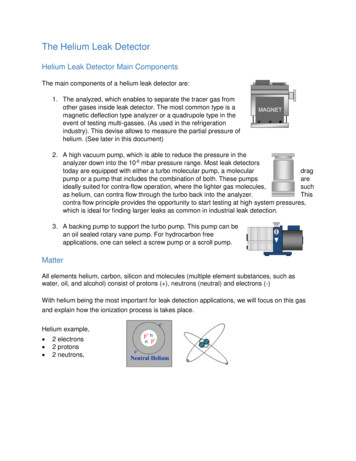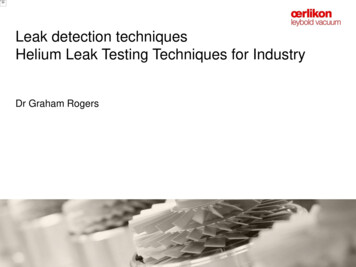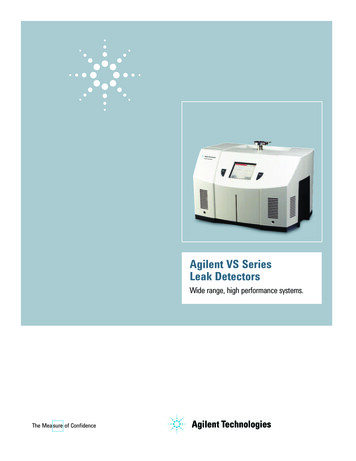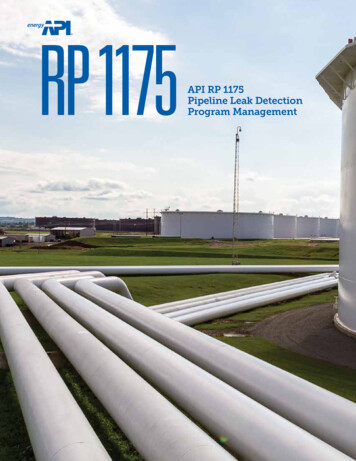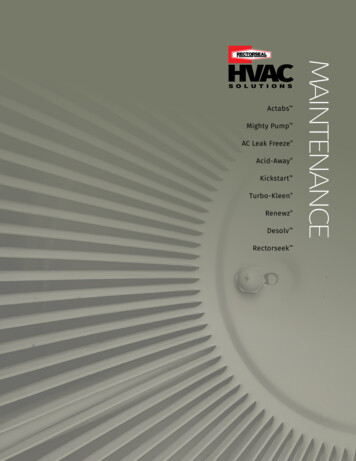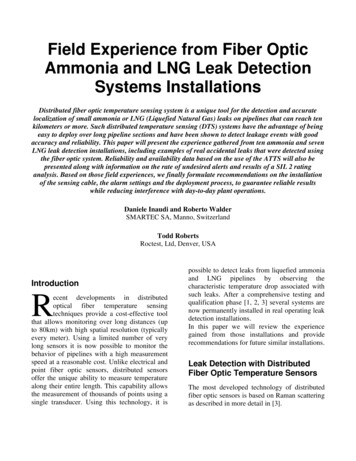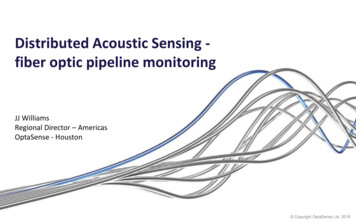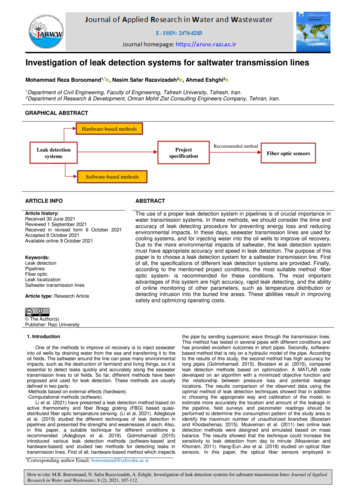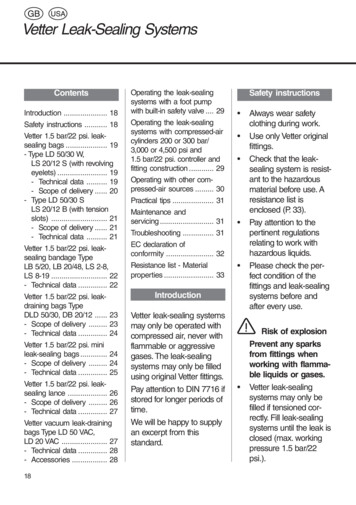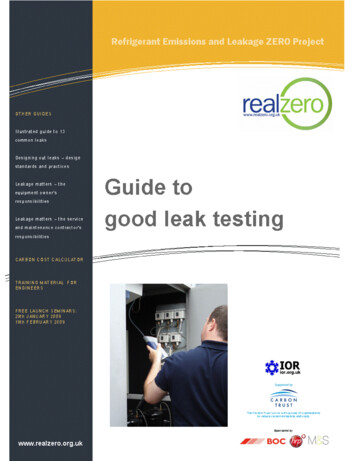
Transcription
Page 0
Guide to good leak testingThe Institute of Refrigeration, working with the Carbon Trust, brings you REAL Zero –Refrigerant Emission and Loss Zero. The aim of this project is in the title – zerorefrigerant loss. The project offers practical assistance to everyone involved inpurchasing, designing, installing, servicing, maintaining and owning refrigerationequipment to help them reduce leaks.1Introduction – why leaks matterPage 22Leak testingPage 33Getting the best from your electronic leak detectorPage 34Pressure testing to find leaksPage 45Leak test procedurePage 56Reducing leakage and common leak pointsPage 67Refrigerant chargingPage 78RecordsPage 79F Gas record sheetPage 810Useful informationPage 9A leak of 1 kg of refrigerant causes approximately the same environmentaldamage as driving a van 10,000 miles.Page 1
Guide to good leak testingCommercial and industrial refrigeration and air conditioning systems leak too muchrefrigerant – leaks of up to 30% of the charge during a year are not uncommon. Leakrates do not have to be this high. Adherence to best practice in service, maintenanceleak testing and repair can significantly reduce refrigerant losses. This guide showsyou how.In this guide, key points are highlighted and include this symbol:Anything which is a legal requirement is in italic text.1. Why leaks matterIncreases costs –service, refrigerant,electricity, downtimeLeakingrefrigerantIncreases adverseclimate change– the “direct” effectReduces system efficiencyIncreases power consumptionIncreases CO2 emissions(at the power station)Increases adverse climate change– the “indirect” effectThere is a legal obligation to reduce leaks and YOU are a key part of thisUnder the European Fluorinated Gas (F Gas) Regulations, we have to takemeasures to reduce leakage. These include: Leak testing systems once a year if the charge is between 3 and 30 kg and twicea year for systems with more than 30 kg.Logging refrigerant usage and leak tests / repairs.Being qualified to handle refrigerant.There is more detailed information on legal requirements throughout this guide.It is illegal to top up a system with refrigerant without first finding andrepairing the leak(s).Page 2
2. Leak testingThe table below lists the three most effective methods for finding refrigerant leaks:MethodEffectivenessComplianceLeak detection spray /soapy waterGood for pinpointing leaks.Allowed under the F GasRegulations.Electronic leak detectorGood for most leaks if thedetector is used andmaintained correctly (seeSection 3 below). Makesure your detector issensitive to the refrigeranttype you are testing.Allowed under the F GasRegulations – the leakdetector must have asensitivity of 5 g/year andshould be checkedannually.Fluorescent additive(injected into the systemwith oil and detected usingan ultra violet lamp)Can be an effectivemaintenance tool for quickleak testing. Can bemessy. The additive mustbe cleaned off after a leak.Coalescent oil separatorsremove the additive so itdoes not circulate in thepipe work andcomponents between theoil separator dischargeand compressor suction.Allowed under the F GasRegulations if approved bythe equipmentmanufacturer – the use ofthe additive voids warrantyon some compressors.3. Getting the best out of your electronic leak detectorElectronic leak detectors are test instruments which need to be looked after, checkedand maintained to ensure accuracy. Under the F Gas regulation it should bechecked once a year. This is a minimum requirement – for optimum reliability theyshould be checked more frequently, e.g. after 25 hours use.Avoid contaminating the detector with oil, and replace the filter (where fitted)regularly.There are two types of leak detector in common use, using different methods ofdetection: Heated diode detectors – thediode needs changing usually after100 hours use. The photo showsa typical heated diode. Infra red (IR) detectors – the IR sensor needschanging less frequently.Page 3
Use a reference leak tocheck your detector isworking correctly – justopening a cylinder or aconnection on thesystem to check yourdetector is not accurateenough. The photoshows a simplecalibrated reference leakthat fits onto thecylinder valve. When thevalve is opened the flowthrough the device isapproximately 5 g / year.If your leak detectordoes not pick this up itneeds servicing.4. Pressure testing to find leaksIf you cannot find a leak using any of the methods above, you should recover thecharge and pressurise with dry (oxygen free) nitrogen. A full procedure is availablefrom the IOR (SES Good Practice Guide 24 – Pressurising installed systems withnitrogen to find leaks). The important points to remember when carrying out atightness test are: A pressure of up to 10 bar g (150 psig) isusually sufficient to find leaks using a soapsolution.Make sure your regulator is in good conditionand does not have an output pressuresignificantly higher than you need (e.g. 10 barg).Do not use a manifold with a sight glass topressure test through. The photo shows aregulator, three-way gate valve and bradedsteel hose assembly which will minimise thehazard of using a high pressure gas.Ensure the regulator is closed (wound out, fullycounter clockwise) when you fit it to thenitrogen cylinder – open it slowly when all theconnections to the system are tight and theaccess valves are open.Make sure the cylinder is secure.A trace of hydrogen or helium with the nitrogen will enableleaks to be found at a lower pressure. A suitable electronicdetector must be used – your standard detector is notsensitive to hydrogen or helium. Nitrogen can be suppliedwith a trace of hydrogen (as shown in the photo) or heliumspecifically for leak testing.Page 4
5. Leak test procedureDon’t forget the following important points when leak testing: Review the F Gas log (see section 9) to check where leaks have been foundpreviously.Choose the most appropriate method, for example - a quick sweep with anelectronic leak detector followed by a leak detection fluid (soapy water) topinpoint the leaks.Be methodical and take your time.Check the whole system, including- Fusible plugs and pressurerelief valves and their ventlines- Couplers (e.g. for pressureswitches and gauges)- Inside pressure switches(as in the photo) – bewarelive electrical connections- Service valve stem glands(and then cap them)- Schrader valves (tighten if necessary and thencap them). Ensure the cap O-ring is in goodcondition (as in the photo) and that the cap istight.If the suction pressure is low (e.g. below 1 bar g, 15 psig),it is better to increase the pressure to find leaks:- Simple condensing unit systems - switch themoff (do not pump down)- Central plant – switch off as a last resort.The first leak you find is usually not the only leak – checkthe whole systemLeak test frequency is covered by legislation:Fluorinated Gas (F Gas) Regulation: Systems containing between 3 and 30 kg of HFCs must be leak tested annually; Systems containing more than 30 kg of HFC must be leak tested twice a year Systems containing over 300 kg of HFC must have permanent fixed leakdetection.If a leak is found it must be fixed and the system re-tested at the point of repair withinone month.Ozone Depleting Substance (ODS) Regulation: Systems containing over 3 kg of HCFC must be leak tested annually.Know where leaks are likely to occur.See REAL Zero “Illustrated guide to 13 common leaks”Page 5
6. Reducing leakageMany factors affect leakage: System design and the components usedThe type of joint and the quality of brazingHow pipes are routed, supported and clippedVibration eliminationThe quality of pressure testing during commissioningStandard of service and maintenanceYou have the opportunity to reduce leakage when you are servicing or maintainingsystems. Conversely, poor service and maintenance will increase the risk of leakageoccurring. See the REAL Zero Guide “Leakage Matters – the service andmaintenance contractor’s responsibilities” for more information.Ensure ALL valves are capped.Uncapped valves are a very common source of leakage.To reduce leakage you should also: Check that pipes are not vibrating excessively and are not chafing - correct ifnecessary.Check pipe clips are adequate and in good condition - replace if necessary.When tightening flanges, tighten the bolts evenly and to the correct torque.When tightening flare nuts, use a torque wrench toachieve the correct torque:- ¼” pipe, tighten to 14 to 18 Nm- 3/8” pipe, tighten to 34 to 43 Nm- ½” pipe, tighten to 49 to 61 Nm- 5/8” pipe, tighten to 68 to 82 Nm.When replacing flared components, used flaresolder adaptors rather than manually made flares. The photos show a standardflare solder adaptor and one specifically designed for expansion valves with aflare inlet.Do not leave line tap valves on systems (onecabinet manufacturer has found that 40% of linetap valves left on systems leak). Use the line tap toaccess the system to diagnose problem. If thesystem is short of refrigerant decant the remainderof the charge and replace the line tap with aschrader before re processing the system.For more information, see the REAL Zero guide to the 13 most common leaks.Page 6
7. Refrigerant chargingThe amount of refrigerant charge is important: Undercharged systems are less efficient, have higher running costs and might notbe able to meet the load.Overcharged systems have greater potential leakage. In extreme cases, overcharging will increase head pressure and reduce performance and efficiency.Charging to a known weight is the most accurate method of achieving the correctcharge - use this when possible, especially on systems without a receiverIf you are charging to a full liquid line sight glass ensure there is a load on thesystem, otherwise you may not charge enough refrigerant to meet a high load. Beaware that bubbling in the sight glass can also indicate that the liquid line filter drier isblocked or the condenser is significantly undersized or blocked.Charging to a pressure or frost line are not accurate methods of achieving the correctcharge amount.8. RecordsUnder the F Gas Regulations, a record must be kept for any system containing morethan 3kg of HFC. The log should include: Total Refrigerant ChargeRefrigerant additions to the systemRefrigerant removals from the systemLeak testsFollow up actionsTesting of automatic leak test systems where fittedThis record is very useful source of information about leak points so that future leakscan be avoided. An example F Gas log sheet is included in section 9. There is arefrigerant logging spreadsheet tool at www.realzero.org.uk which enables you torecord refrigerant additions and removals, leak tests and repairs. It also provides asummary of the refrigerant usage (as a percentage of system charge) per systemand its carbon equivalent.Page 7
9. RECORD SHEET FOR F-GAS REGULATIONGeneral informationPlant nameReference no.Location of plantPlant operator (name, address, telephone)Operator contactCooling loads servedRefrigerant typeRefrigerant quantity (kg)Plant manufacturerYear of installationRefrigerant additionsDateTechnician/companyAmount added, kgReason for additionAmount removed,kgReason for removal. Whatwas done with recoveredrefrigerant?Refrigerant removalsDateTechnician/companyLeak testsDateTechnician/companyTest result (includinglocation and cause of anyleaks identified)Follow-up actionsrequiredFollow-up actionsDateTechnician/companyRelated to testonActions takenTesting of automatic leak detection system (if fitted)DateTechnician/companyTest resultPage 8Comments
10. Useful informationList of common HCFCs and HFCsTypeRefrigerant examples(the most common refrigerants are in bold type)EU RegulationOzoneF GasHCFCR22, R123, R124, R141b, R142b98HCFCBlendsR401A, R401B, R401C, R402A, R402B,R403A, R403B, R406A, R408A, R409B, R411B99HFCR134a, R32, R12589HFC BlendsR404A, R407C, R410A, R413A, R416A,R417A, R422D, R423A, R507, R508, FX100,RS44, RS45, RS5289OtherAmmonia (R717), CO2 (R744), hydrocarbons(e.g. propane)88Regulations EC Regulation 842/2006 on certain fluorinated greenhouse gases. Referred to asthe Fluorinated Gases (F Gas) Regulations which aim to reduce emissions ofHFCs, PFCs and SF6 and whose key obligations came into force in July 2007.EC Regulation 2037/2000 on substances that deplete the ozone layer. Referredto as the Ozone Depleting Substances (ODS) Regulations which phase out andcontrol uses of ozone depleting substances and has been in force since 2000.HCFCs are the main type of substance still to be phased out under thisRegulation and virgin HCFC cannot be used for servicing systems after31.12.2009.F Gas support – for more detailed information about the practical application of theregulation, contact:0161 874 -Gas Support, P O Box 481, Salford, M50 3UDRefrigerant handling qualifications – mandatory for anyone handling HCFCsand HFCsCity and Guilds 2078 and the current (Nov 2008) CITB safe handling of refrigerantqualification are acceptable until July 2011 after which anyone handling HFCs musthave either City and Guilds 2079 or the new CITB refrigerant handling qualification.For more information, see www.acrib.org.ukThe Institute of Refrigeration accepts no responsibility for errors or omissionsPublished January 2009Page 9
Commercial and industrial refrigeration and air conditioning systems leak too much refrigerant - leaks of up to 30% of the charge during a year are not uncommon. Leak rates do not have to be this high. Adherence to best practice in service, maintenance leak testing and repair can significantly reduce refrigerant losses. This guide shows you how.
